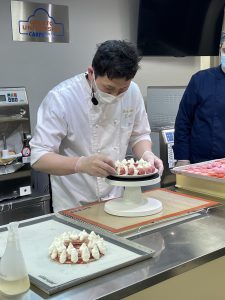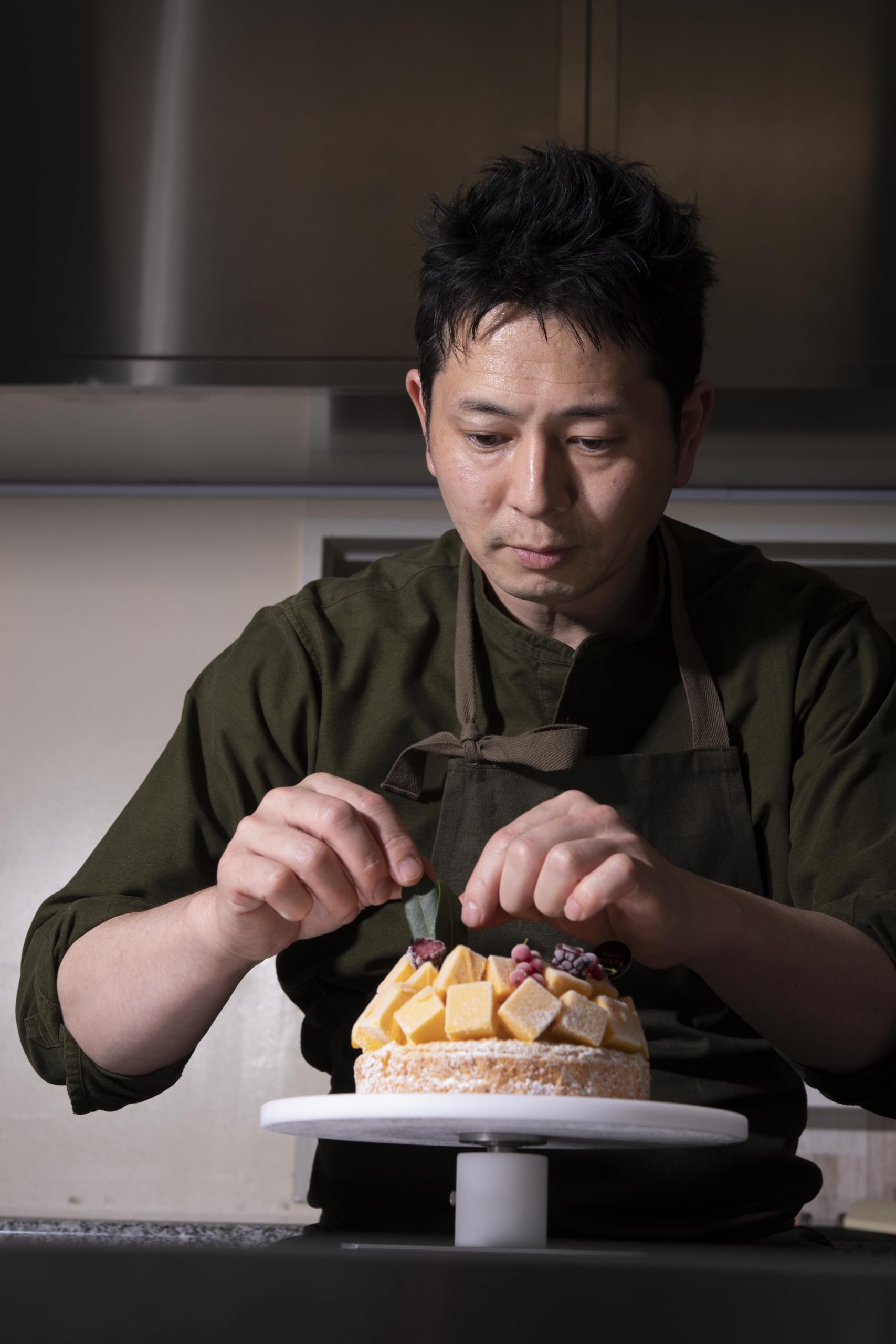Pastry or ice cream: what matters most? The Japanese Hiroyuki Emori has been one of the first chefs in the world to decide that this was not a choice to make, but a precious fusion!
Chef Emori (Maison Givrée(メゾン ジブレー)」) clearly showed it off when he won the FIPCG World Championship of Pastry, Chocolate, and Ice Cream, in 2015. All his creations were perfectly balanced, in harmony. His initial training is as a pastry chef – he worked at the MOF Pâtisserie Fresson for two years – allowed him to successfully combine both disciplines. From Glaciel to Maison Givree, he keeps surprising and delighting gourmets all around the world. Frozen Art Chef is pleased to unfold the thoughts and the secrets of one of the pioneers of the Gelato Pastry University, able to unify his two pastry and ice cream souls.
1.Emori san, tell us more about you.
I’m 47 years old. After graduating at the University, I attended a Patisserie College and I started working at the famous Avril de Bergue pastry shop in Yokohama. After 8 years, I moved to France and I worked at Frenk’s Fresson Patissier (a MOF, Meilleur Ouvrier de France) for 2 years. Chef Fresson taught me how to work with ice cream, using care and ingredients of the highest quality, natural and fresh, that come from the collaboration with small producers. Back to Japan, I had the knowledge and the experience to be Chef. First, I came back at the Avril de Bergue pastry shop, then, I wanted a further ice-cream challenge and I joined Glaciel, a renowned ice-cream cake shop in Tokyo. After three years, I started my own consulting business. I also focused on competitions: I won the FIPCG World Championship of Pastry, Chocolate, and Ice Cream in 2015 and I took part at La Coupe du Monde de la Pâtisserie twice. In 2017, I opened my pâtisserie shop, Maison Givrée.
2. When did you start dreaming to be a Pastry Chef and what did you do?
I was at the 4th year of the University. I went to a Patisserie College in Japan and I worked hard in a pastry shop for years. Then, in order to become a well-rounded professional chef, I studied French very hard. I always dreamt to work in other countries and especially in France. After the experience at Fresson, and back to Japan, I wanted to become a Pastry Champion. I started training hard after work and here I am.
3. How is Gelato doing in Japan?
The gelato market in Japan keeps growing; production and consumption volumes are increasing. I’ve been working hard to spread the gelato culture in Japan. I started my career as a pastry chef and not only do I teach gelato but also torta gelato (=gelato cake), my favourite gelato pastry creation. About 10,000 cakes were sold during the past Christmas season.

4. Will the gelato-pastry trend grow more?
In Covid times people started sending gelato and torta-gelato as a gift. In Japan, the delivery system is punctual and gelato fits this business style at the best. It’s a great opportunity, especially now as it’s still not easy to visit shops in Japan. Many customers used to come to my shop from far places, however thanks to the delivery service and the Japanese culture to send gifts to each other on many occasions (Japanese people originally bought ice-cakes to celebrate birthdays, Christmas and other Japanese holiday related events), I strongly feel that more people will choose torta gelato and gelato pastries as a gift.
5. Gelato-Pastry and Gelato-Bakery: perfect matches?
Absolutely. Gelato hasn’t been explored enough yet: it’s surprising when combined with bakery or pastry products, coffee and cocktails. You only have to find the right flavours, the perfect balance.
And always focus on your clients. If you try to sell my cakes outside Japan, you may want to check if your customers love the taste: some countries are not used to dairy milk, so you may want to substitute it with soya, rice, almond or oat milk. Anyway, I never visited a country where people didn’t like gelato and I believe that it has got a high potential everywhere.
Speaking about Japan, I’m actually working with Japanese farmers and local governments to revitalise the economy. Not only can gelato realised with specialty and seasonal fruit support local businesses, but it can become a powerful marketing channel. When people taste uncommon flavours and love them, they will be willing to buy the original products in the market.
6. What is your relationship with Frozen Art?
The possibility to create new standards attracts me, Frozen Art is still a new trend. The technique is similar to pastry, but gelato is easier to assemble, so a gelato-cake is more suitable to build up for decorations.
Another advantage? Gelato has both a white base and a fruit base, and when choosing a fruit base, you can create and design infinite colours.
Imagination is your only limit.
7. Where did you learn to make ice cream and gelato?
I started making gelato in France, while working at Fresson. When back to Japan, I had more opportunities to make gelato using Carpigiani machines and participating in worldwide competitions. Getting specialised at the Carpigiani Gelato University in Bologna was the final step. First, I learnt the basics, and the following year I studied innovative techniques (vegan and bio gelato, gastronomic recipes, gelato with alcohol…). What I learnt in Italy 5 years ago is happening now in Asia. These experiences gave me confidence and more ideas.
8. How many times have you been to Italy?
More than 10 times. I visited SIGEP (the world’s leading B2B show dedicated to dessert-and-coffee Foodservice industry) every year since I started my gelato-pastry adventure, as well as Carpigiani Gelato University. I also organised private trips. I visited Italy more than France.
9. European and Japanese gelato-pastry. What’s the difference?
I’m following the process learnt in Europe; it’s fundamental and doesn’t change. The big difference is how you think about “sweetness”. First, Japanese people do not have a sweet tooth. I also recently realised that sugar doesn’t bring out the real aroma of fresh fruit.
Lastly, in Japan, we have access to limited sugars, while in Europe there are so many options and combinations that you may be tempted to experiment a new sweetness for each of your creations. In Japan, the focus is more on bringing out the original aroma of your ingredients.
10. Please share with us one of your recent creations.
Here’s for you, my Entrêmet Glacé Champignon Framboise video recipe. I assembled this torta-gelato to be appreciated all around the world and I presented it a few weeks ago in a masterclass that celebrated the 5th Anniversary of Carpigiani Gelato Pastry University. Although I used Japanese sugar for this creation, I researched a balance that can make it tasty outside of Japan too. I worked hard to bring out the aroma of the ingredients and I adjusted the sweetness and the hardness of my torta-gelato many times. Frozen Art Chefs, share your feedback!

11. Any tip to become successful gelato or gelato-pastry entrepreneurs?
It’s still not easy to start a “solo” gelato business in Japan, but if you have a good idea, plan your investment, prepare your recipes and go ahead! Remember to create a system that immediately enables you to reach out to consumers. Many gelato entrepreneurs produce good gelatos but they don’t know how to find their clients. While working with local governments, I learnt how to make business cycles. There are many opportunities in the market if you think out-of-the-box.
To start a gelato-pastry business, it is important that you succeed in a pastry business first. Once you have this knowledge, study the basics of gelato and start offering it to your customers.
I judged many gelato competitions in Japan and when I read the recipes, I often realised that some participants misunderstood the balancing rules. If you don’t learn the fundamentals, you’ll never be able to win a competition.
I don’t want to say that you shall open a gelato shop only after winning a competition, but studying about gelato is the key to success. You can predict the taste of a gelato just by reading its recipe.
12. Gelato trends: what’s next?
The gelato market will be much bigger in the future. Famous ice cream companies are already increasing the range of their flavours, as people ask for more sophisticated products. And if a basic ice-cream used to cost 50-100yen (at least $1), the price of the new products is 200-300yen. People are willing to pay more for quality. Also, the ice cream that you find at a convenience store (the local corner shops open 24/7) are selling premium ice-cream. The following step is gelato, right? As it’s easy to make a great gelato if you have the right recipe, I predict that convenience stores might offer gelato in the near future. Are we ready to have convenience stores as competitors?
Of course, it would help to expand the market and make gelato appreciated by more customers, but local gelato entrepreneurs must strengthen their own unicity soon.
It already happened with coffee, in Japan. People started looking for better quality, they didn’t hesitate to pay more in order to feel a unique taste. Famous baristas are trendy in Japan and I think that creative gelatieri may become famous too!
I also think that the delivery service will increase its popularity, even after this Covid emergency. People are enjoying the possibility to taste high-end gelato comfortably at home, wherever they live.
13. Last question: what’s next for Chef Emori?
First, I’ll keep working to make each of my customers happy with my gelato-pastry. Secondly, I’ll do my best to enlarge Maison Givrée’s delivery service, but I’ll never compromise on giving my clients the feeling to be “the only ones”.
Thirdly, I’m ready to work on bigger projects with institutions and local farmers. My goal is to start a new movement and make our society happier through Gelato.
I’ve been dreaming it for a while… What about a “Gelato Peace Party” realised with the Japanese politicians? Gelato makes everyone happy, it doesn’t matter if you are rich or poor. And there are many opportunities for many farmers and workers, as already happened with chocolate in other countries of the world (just think about the fair-trades and the importance given to cocoa farmers and workers inn Africa and South America). I’m thinking about Japanese fruit farmers now. They produce the ingredients, I create the recipes, shops will sell specialty local gelatos and everyone will be richer and happier. It sounds simple, right?




